Table of Contents
Social shopping: Social media meets eCommerce.
In a world where 90% Instagram users follow business profiles and 93% of consumers say online reviews have an impact on their purchase decision, brands can’t afford to ignore this merge. Check out these customer photo examples to see how 14 brands are ruling instagram with their UGC strategies.
In this post, we’ll dive into the idea of social shopping: What it is, why you should care, and how to use it.
Let’s get started.
Why not find out how to craft the perfect instagram captions for eCommerce?
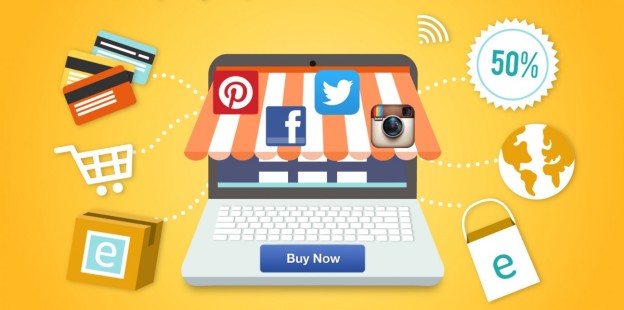
Social shopping is a crossroads between social media and eCommerce. While there are websites dedicated to it’s practice, those websites aren’t social shopping in and of themselves.
Some examples of such sites include:
While these sites can have an impact on your brand (many of them allow you to add your products), social shopping is so much more. It’s the blend of social media with shopping aspects.
Social shopping is the act of using social media to find reviews and recommendations about products (either products you’re actively searching for or those you happen to stumble upon), then using those reviews to guide your purchase decision.
In other words, it’s the dialogue occurring about your brand and your products. It’s the good, the bad, and the ugly.
Now, you’re probably wondering: why should you care?
People are already talking about you on social media. They’re already comparing your product and listening to peer recommendations of what to buy. If you’re not there, you have no input in the dialogue.
Here’s a case study on Levi’s to help you understand. Levi’s took social shopping to a whole new level by integrating social media into their website. They even went so far as to incorporate what they called a “friend store” – a specific section of their site where you only see what your friends liked or purchased via Facebook.
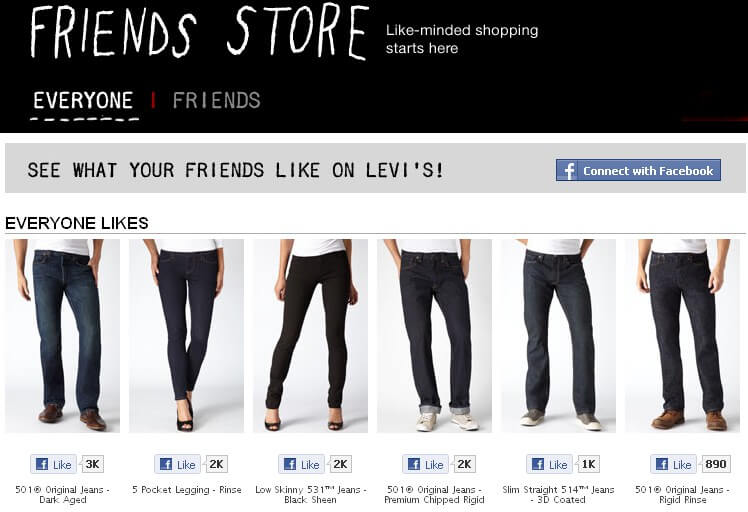

Their intimacy with social media and eCommerce led to 30% of their entire web traffic coming from Facebook. They went from 180,000 fans in 2009 to over 26 million!
Still not convinced? Here are a few interesting stats:
There you have it – people are listening to their peers before buying anything, and half of us are willing to pay more for good stuff.
These numbers are only going to increase. Social shopping works because it puts the control in the hands of the customer, and that’s exactly what they want. Consumers are becoming more intelligent as the internet grants us free access to more information.
No one wants to make a poor purchase decision. Have you ever bought something that you were really excited about, and it turned out to suck? It’s not a good feeling. Social media helps people avoid that scenario by learning from others who already went through it.
You’re convinced – good. You’ll need to be if you want to get serious about social media eCommerce.
Getting involved with social shopping isn’t incredibly difficult. If you’re already on social media, it’s merely the act of tuning into the conversations happening about your brand and engaging with your followers.
Here are a few tips to get you going:
The first step is to see what people are already saying. Look for and monitor mentions of your brand.
You can do this by going to a site like Twitter and searching for #YourBrand. (Of course, replacing “YourBrand” with the name of your brand.) For example, I searched for #PhotoSlurp:
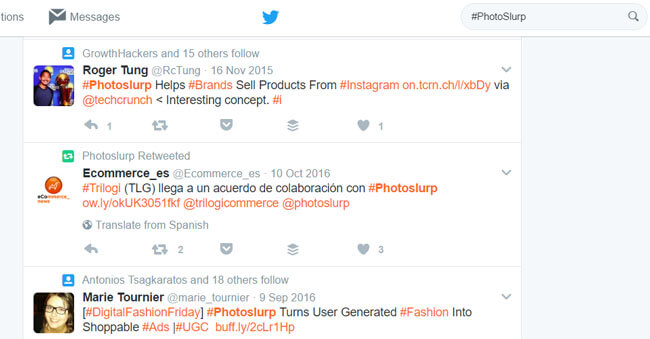
As you can see, Flowbox has gotten mentions from people who didn’t tag us directly. While you may not find a lot of interaction this way, it’s still worth taking a look.
For more ways to find mentions of your brand, check out these five tools covered by Social Media Examiner.
Another way you can see what’s said about you is by doing a quick Google search of your company and “bad reviews” or “scam”.

If something comes up, you’ll see what people are saying about you. You may even find these sites are completely lying about you. If that’s the case, a lawsuit may be in order!
Once you’ve discovered how you’re being mentioned, it’s time to up your support game.
One of the best and easiest ways to get involved in customer conversations is to provide support via social media. Facebook live chat is the most obvious solution, but another route many bigger companies are taking is to create an entirely separate Twitter account just to handle support issues.
For example, Medium has their regular Twitter account in addition to a support Twitter account.

Twitter even changes their display text from “Following” to “Provides support”, as you can see above. Plus, a dedicated support handle means you won’t have to worry about questions from followers getting lost in a series of brand mentions.
If you don’t have the resources to create a dedicated support account, you’ll want to make sure you keep a very close eye on your brand mentions to ensure customer support issues don’t fall through the cracks.
In case you need an extra push to offer social support, Sprout Social found that it’s most people’s top choice for customer care.
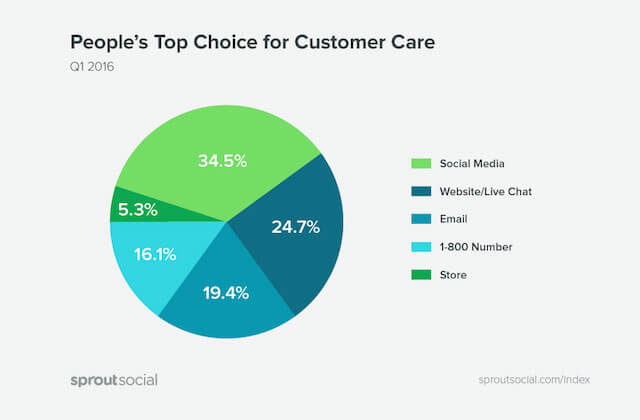
Additionally, you’ll want to make sure you answer quickly if you start using social as a support channel. Research has shown that 42% of followers expect a response within one hour and 32% expect to hear back within just 30 minutes.
It sounds like a lot – and it is. But, it’s in your best interests to try to oblige. Conversocial reported that 88 percent of consumers are less likely to purchase from a company that leaves questions on social media unanswered.
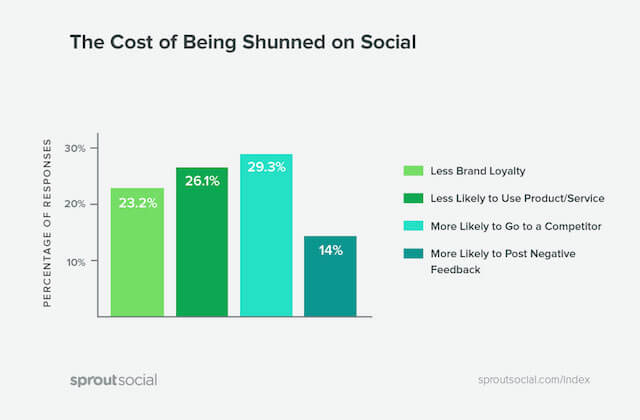
One final word of advice for providing social support: Show your true colors! Don’t be afraid to be a little weird and wacky. Here’s a fun example by Sainsbury’s to give you some inspiration:
@TeaAndCopy I feel that some fin should be done to sort it trout. You shouldn’t have that hassle when trying to spend a few squid. David.
— Sainsbury’s (@sainsburys) January 10, 2014
Offering this kind of social support requires a shift in focus…
Ultimately, social shopping has nothing to do with you. It’s all about your customers.
Have you ever seen a brand showcase customer photos wearing that brand’s clothes or using their products? That’s called User Generated Content (UGC) and it works incredibly well. User Generated Content is 50% more trusted than any other media.
But there’s more:
The verdict is in: You need to be engaging with your follower’s content. That includes integrating customer photos in your eCommerce store and encouraging UGC through social media campaigns. This can be easily done through an advanced UGC platform such as Flowbox.
However, it’s time to get serious.
Merely being on social media isn’t enough. Why are you on each platform? What is your goal? You need a written strategy to see real success.
This reminds me of something I heard Earl Nightingale say in his book, The Strangest Secret:
“Think of a ship with the complete voyage mapped out and planned. The captain and crew know exactly where the ship is going and how long it will take, and it has a definite goal. 9,999 times out of 10,000, it will get there.
Now let’s take another ship just like the first, only let’s not put a crew on it, or a captain at the helm. Let’s give it no aiming point, no goal, and no destination. We just start the engines and let it go. I think you’ll agree that if it gets out of the harbor at all, it will either sink or wind up on some deserted beach. It can’t go anyplace because it has no destination and no guidance.”
It’s the same thing with your social media strategy. Randomly posting things, commenting on things, and following people is like a ship without its crew – you’re not likely to get anywhere because you don’t even know where you’re trying to get.
If you’re lucky enough to succeed at all, it will be nothing but luck. It will be random and you won’t be able to replicate what worked because you won’t know why it worked.
Here’s what you need to get started with a social media strategy:
Once you’ve gone through those steps, I can almost guarantee you’ll see the results you’re looking for.
Pro Tip: You can also add social shopping elements like a shoppable Instagram to increase conversions from your social channels.
In 2018, there were more than 5 billion mobile device users and almost 3 billion smartphone users worldwide. 80% of those people grab their smartphone within 15 minutes of waking up. According to Google, 85% of online shoppers complete a purchase on a device other than the one where they started. We’re in an era where people will begin their search for products on their phone, take it to their tablet, then end on their desktop!
Those people, constantly on their phones, are also using social media. Social has become an integral part of the modern life – not being in front of these people is a huge mistake.
Not to mention the integration of social shopping and mobile. Buy buttons are cropping up across nearly every social media channel. Pinterest has been pretty successful doing this, in particular.

Besides, mobile isn’t going anywhere. If we don’t design our stores to be mobile-friendly, we’ll lose out on a lot of traffic and fall behind the competition.
I’ll leave you with one last stat in case you need an extra push: Multichannel shoppers not only shop more often but also spend 15% more per purchase than those who shop just on one channel. That can’t be ignored.
We live in a world where 1.66 billion people log onto Facebook daily and spend there, on average, 58 minutes on Facebook every day. We’re constantly connected to the tiny device in our pockets.
As technology gets smaller and less expensive, and mobile data and internet access becomes cheaper, people will continue to be even more connected. Social media has become an integral part of the modern person’s life.
If you’re not on board with that, your business will fail. You won’t be able to keep up. Your competitors will outpace you.
Don’t wait – start a social media strategy today. Embrace social shopping and add shoppable elements to your social accounts.